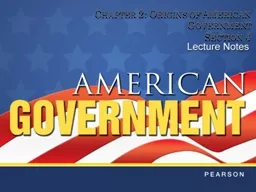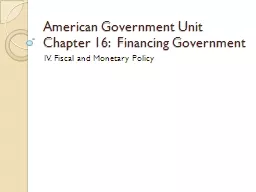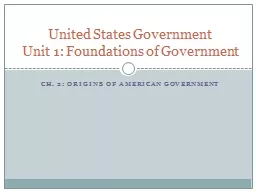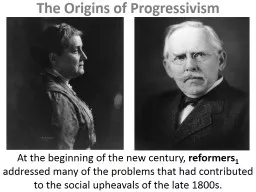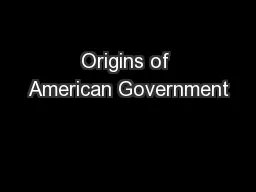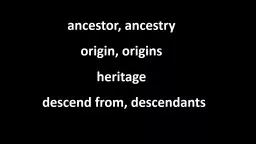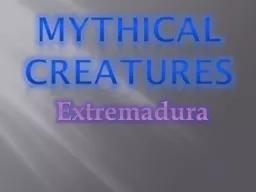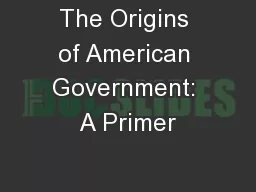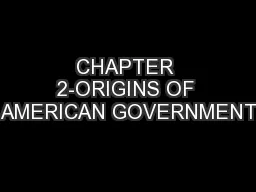PPT-Chapter 2: Origins of American Government
Author : myesha-ticknor | Published Date : 2016-10-20
Section 4 Objectives Identify the Framers of the Constitution and discuss how they organized the Philadelphia Convention Compare and contrast the Virginia Plan and
Presentation Embed Code
Download Presentation
Download Presentation The PPT/PDF document "Chapter 2: Origins of American Governmen..." is the property of its rightful owner. Permission is granted to download and print the materials on this website for personal, non-commercial use only, and to display it on your personal computer provided you do not modify the materials and that you retain all copyright notices contained in the materials. By downloading content from our website, you accept the terms of this agreement.
Chapter 2: Origins of American Government: Transcript
Section 4 Objectives Identify the Framers of the Constitution and discuss how they organized the Philadelphia Convention Compare and contrast the Virginia Plan and the New Jersey Plan Summarize the conventions major compromises and the effects of those decisions . Nature and Origins of Meteoritic BrecciasWestf IV. Fiscal and Monetary Policy. Objectives. Describe the overall goals of the Federal Government’s actions in the economy.. Explain the features and purposes of fiscal policy.. Explain the features and purposes of monetary policy.. United States Government. Unit 1: Foundations of Government. An English Political Heritage. English colonists brought with them a heritage of individual freedom & principals of government that shaped the development of the United States.. At the beginning of the new century, . reformers. 1. . addressed many of the problems that had contributed to the social upheavals of the late 1800s.. The Origins of Progressivism. Journalists and writers exposed the unsafe conditions that factory workers, including women and children, often faced.. U.S. Government Chapter 2. Section 1: The Colonial Period. English Political Heritage. Section 1: The Colonial Period. English Political Heritage. Limited Government . Section 1: The Colonial Period. ancestor, ancestry . heritage . d. escend from, descendants . P. hysicist, oceanographer and broadcaster. Politician, Labour MP. English international cricketer. Film director. TV P. resenter, businesswoman. Week . 8. Macro-Outcomes:. Emergence of Democracy. Brian Downing. Ph.D. University of Chicago. 1992. . The Military Revolution and Political. Change: The Origins of Democracy and. Autocracy in Early Modern Europe.. Could WWII been prevented?. Europe After World War I. World War I caused the deaths of millions and the destruction of numerous cities and farms. The European economy was in ruins.. The Treaty of Versailles left many European nations unhappy.. . creatures. Extremadura. Introduction. We are going to talk about all the mythical creatures that are traditional in our region. Some are nice, some are scary, but they are all original from Extremadura. Our . Anthony Fitzpatrick. The Magna . Carta. 1215: King John agrees to –. Preserve the Freedom of the Church and to hear petitions from the barons.. Remove foreign armies from England.. Not to seize land to pay for debts.. Chapter 2-Section . 1-Our . Political Beginnings. Pg.30-35. BASIC CONCEPTS OF GOVERNMENT. Earliest settlers had knowledge of political systems. Political system was based on practices in England. ORDERED GOVERNMENT. Chapter 2 Section 1. The Colonial Period. English colonists brought with them a heritage of freedom and principles of government that helped shape the development of the United States.. The American government was founded on five basic principles from English government.. Intellectual Origins . Write down your opinion to the question: Can ideas cause a revolution? Explain your answer.. Intellectual Origins. Intro:. It is not an uncommon argument (both by historians and others) to suggest that the American Revolution was started by ideas or ideals. Animal Liberation Front. Origins . Hunt Saboteurs Association (HSA)- 1962. John Prestige . Committed to nonviolence. Band of Mercy-1970s. Break away group of HSA (Sabbers). Named after Victorian Youth Wing of the Royal Society for the Prevention of Cruelty to Animals.
Download Document
Here is the link to download the presentation.
"Chapter 2: Origins of American Government"The content belongs to its owner. You may download and print it for personal use, without modification, and keep all copyright notices. By downloading, you agree to these terms.
Related Documents

